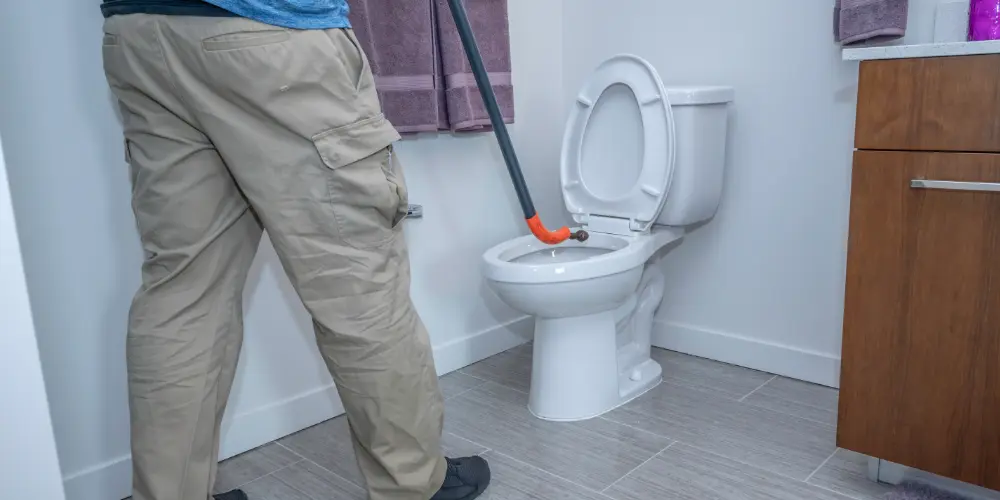Clogged toilets are a homeowner’s nightmare and a stinking mess.
Most clogs clear quickly enough with a few plunger thrusts, but what about those that don’t? Suppose Junior stuffed a toy or two down the bowl, or someone (maybe you) got overgenerous with the sanitary paper?
What are your options when a plunger is no longer up to the job?
Enter the auger, a handy and inexpensive plumbing tool for toilets that fail to comply with the flush command.
Toilet Auger Vs. Drain Snake: What’s the Difference?
Never, ever use a drain snake to clear a toilet clog. Augers and snakes do similar things but are very different tools. Here’s how:
- Design and Purpose: Augers with curved ends can navigate the toilet trap without damaging the porcelain. Drain snakes are more versatile and deeper-reaching but lack the protective features required for toilets.
- Length and Flexibility: Augers are shorter and more rigid, allowing them to push through the toilet clog without bending. Drain snakes are longer and more flexible to reach deeper and less uniform clogs.
- Protective Sleeve: Augers come with a protective rubber sleeve that prevents scratches and damage to the porcelain surface of the toilet bowl, which is absent in standard drain snakes.
- Ease of Use: Unclogging a toilet is a more straightforward process with an auger designed to clear toilet clogs.
NOTE: Some toilet manufacturers may void warranties if you use a plumbing tool like an auger or snake on their products.
Choosing the Right Auger for the Job
Types of Augers
- Manual Toilet Auger: This is the most basic and widely used type. It consists of a long metal rod with a curved end designed to hook clogs. Cranking the handle pushes the auger through the blockage.
- Electric Toilet Auger: An electric auger offers additional power for more stubborn clogs. It works similarly to the manual version but uses an electric motor to enhance the auger’s force. Electric augers are particularly useful in commercial settings or for particularly tough clogs.
- Closet Auger: A closet auger’s telescoping tubes reach further into the toilet trap. This type of manual auger has a comfortable grip handle for easy maneuvering.
How to Choose the Right Auger
- A manual auger usually suffices for routine clogs. However, an electric auger might be necessary for challenging blockages, particularly those involving toys or non-biodegradable items.
- If you frequently encounter clogs or need a tool for professional use, investing in a higher-grade electric auger can save time and effort.
- Ensure the auger has a comfortable grip and is easy to maneuver. The telescoping feature in some closet augers helps to clear deep-set blockages.
Auguring a Toilet Step-by-Step
The Unclogging Process
- Always wear rubber gloves to protect your hands from bacteria and chemicals.
- Remove bath mats, trash cans, or other items around the toilet to give yourself ample workspace.
- Carefully insert the auger into the toilet bowl, aiming the curved end towards the drain opening.
- Slowly crank the handle clockwise, extending the cable into the drain. Keep turning until you feel resistance, which indicates you’ve reached the clog.
- Continue cranking to break up or hook onto the clog. Use pushing and pulling motions to work the cable through the blockage.
Post-Cleaning Tips
- Flush the toilet multiple times to ensure the clog is completely cleared. Then, clean the toilet bowl and surrounding area thoroughly.
- Clean the auger after use to prevent rust and maintain its effectiveness. Store it in a dry place.
- Monitor your toilet’s performance over the next few days. If you notice slow drainage, there could be remaining debris.
Additional Pro Tips
- Regularly inspect and clean your toilet to prevent future clogs. Simple measures like not flushing inappropriate items can go a long way.
- If you can’t clear the clog after multiple attempts, it may be time to call a professional plumber. Persistent issues could indicate a more severe problem, like a broken sewer line.
- Always keep a plumbing auger and other basic tools readily available to save time and stress during emergencies.
FAQs About Toilet Augers
Q: What’s the difference between a toilet auger and a snake?
A toilet auger is designed for toilets, with a specialized head that prevents damage to the porcelain. A drain snake is more versatile but less effective for toilets.
Q: How often should I use a toilet auger?
Only when you experience a clog that can’t be cleared by plunging. Regular maintenance and proper toilet use can minimize the need for an auger.
Q: What should I do If the auger doesn’t work?
There might be a more severe blockage or an issue further down the sewer line. Call a professional plumber for help.
Q: Is a plumbing auger the same thing as a toilet auger?
The terms are often used interchangeably. However, a plumbing auger can also be used for other household drains, while a toilet auger is designed just for toilets.
Q: Can a toilet auger damage my toilet?
No, not if applied correctly. The tool has a protective rubber sleeve to prevent scratches and preserve the integrity of the porcelain surface.
Q: Is it necessary to turn off the water supply before using a toilet auger?
No. However, you should avoid flushing the toilet during the process, as this could cause overflow. Once the clog is clear, you can flush to check the water flow and functioning.


